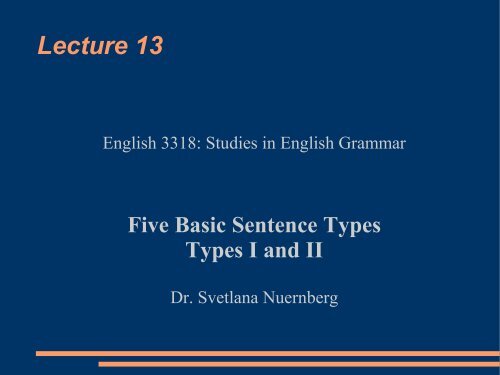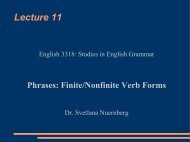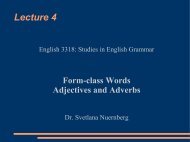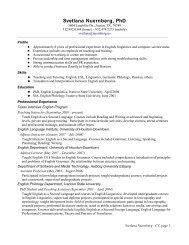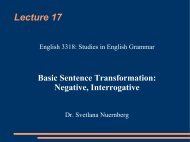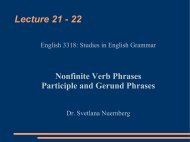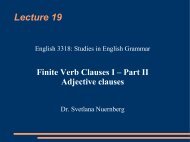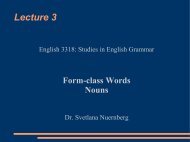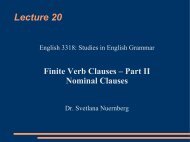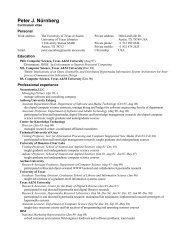Five Basic Sentence Types: Types I and II
Five Basic Sentence Types: Types I and II
Five Basic Sentence Types: Types I and II
Create successful ePaper yourself
Turn your PDF publications into a flip-book with our unique Google optimized e-Paper software.
Lecture 13<br />
English 3318: Studies in English Grammar<br />
<strong>Five</strong> <strong>Basic</strong> <strong>Sentence</strong> <strong>Types</strong><br />
<strong>Types</strong> I <strong>and</strong> <strong>II</strong><br />
Dr. Svetlana Nuernberg
Objectives<br />
●<br />
●<br />
●<br />
●<br />
●<br />
●<br />
Distinguish among be, intransitive, linking <strong>and</strong><br />
transitive verbs<br />
Recognize the five basic sentence types on the<br />
basis of the verb <strong>and</strong> its complements<br />
Differentiate between adverbial <strong>and</strong> adjectival<br />
verb complements<br />
Recognize both adverbial <strong>and</strong> nominal subject<br />
complements<br />
Distinguish among direct object, indirect object<br />
<strong>and</strong> object complements<br />
Draw phrase structure trees <strong>and</strong> Reed-Kellogg<br />
diagrams for each of the five sentence types
Binary Structure<br />
●<br />
Binary Structure – is a two-part structure of a<br />
sentence<br />
– NP – functioning as a subject<br />
– VP – functioning as a predicate<br />
● can be solely a MVP with its single verb<br />
● can be accompanied by compliment (words, phrases, clauses –<br />
that complete the predicate)<br />
● modifiers (add to or modify the meaning of the verb)<br />
● S NP + VP<br />
S<br />
NP<br />
Our neighbor's pet<br />
VP<br />
is outdoors constantly
Type I – The Intransitive Type<br />
●<br />
●<br />
Consists of a subject followed by a predicate in<br />
which there is only one verb followed by an<br />
optional adverb<br />
Intransitive verb can st<strong>and</strong> alone in a verb phrase<br />
<strong>and</strong> function as entire predicate<br />
S 1<br />
= NP + MV int<br />
+ (ADVP)<br />
ADVP<br />
NP<br />
S 1<br />
MVP<br />
VP<br />
Mv int<br />
Fish<br />
swim<br />
A telephone is ringing loudly
Type I<br />
● ADVP PREP<br />
– ADVP – represents a function<br />
– PREP – represents one of the forms that can fulfill that<br />
function<br />
● The bus stops here on Monday S 1<br />
= NP + VP (MVP +<br />
ADVP pl<br />
+ ADVP tm<br />
(PREP+NP)<br />
● ADVP NP<br />
– ADVP - represents a function<br />
– NP – represents one of the forms that can fulfill that<br />
function<br />
● The bus stops here each Monday S 1<br />
= NP + VP (MVP +<br />
ADVP pl<br />
+ NP (DET+NP))<br />
● Hans called three times S 1<br />
= NP + VP (MVP +NP (DET +<br />
NP))
Tests to Identify Type I <strong>Sentence</strong>s<br />
●<br />
Intransitive Verb<br />
1. You can test whether a verb is intransitive by<br />
dividing the predicate into phrases. If all the<br />
phrases except the main verb phrase are optional<br />
adverbial modifiers, then the verb is intransitive<br />
2. If you can substitute a prototypical adverb (like<br />
here, then, or slowly) for the phrase, it is an<br />
adverbial phrase
<strong>Types</strong> <strong>II</strong> – The Verb Be Requiring<br />
Adverbs of Time or Place<br />
●<br />
<strong>Sentence</strong> constituents contain a noun phrase subject,<br />
a main verb be (am, is, are, was, were, being been),<br />
<strong>and</strong> an obligatory adverb phrase<br />
– the main verb be requires an adverbial complement<br />
(outside, yesterday) – refer to the place or time of the<br />
subject eg: The train departs at noon<br />
– the main verb be links the subject with its adverbial<br />
complements – linking (copular) verb<br />
S <strong>II</strong><br />
S <strong>II</strong><br />
= NP + Mv be<br />
+ ADVP tm/pl<br />
NP<br />
MVP<br />
VP<br />
ADVP tm/pl<br />
Mv be<br />
Her job interviews were yesterday
Type <strong>II</strong><br />
●<br />
●<br />
Adverb phrases of place <strong>and</strong> time include: inside,<br />
upstairs, here, away, nearby, then, now, today,<br />
tomorrow<br />
– Jesse is upstairs<br />
– Her doctor's appointment is tomorrow<br />
Prepositional phrases of time (in the evening) or<br />
place (at the post office) <strong>and</strong> noun phrases (next<br />
week, Sunday) can function adverbially<br />
– Cheryl's notebook must have been on the desk<br />
– The concert will be next week
Tests for Identifying Type <strong>II</strong><br />
<strong>Sentence</strong>s<br />
●<br />
Linking Verb Be with Adverbials of Time or Place<br />
1. Is the main verb a form of be? If the answer is<br />
yes, apply the next test<br />
2. Is the form of be followed by an adverbial phrase<br />
that expresses location or time? If the answer is<br />
yes, the sentence is type <strong>II</strong>
Peripheral Cases – Intransitive Verbs<br />
●<br />
We have characterized the prototypical Type I<br />
verbs as intransitive verbs – for which an adverb<br />
modifier is optional<br />
– a number of verbs are like intransitive (are followed by<br />
adverb phrases), however they are not able to st<strong>and</strong><br />
alone as the intransitive (they are more like the be<br />
verbs of Type <strong>II</strong>)<br />
●<br />
●<br />
●<br />
Cheryl's notebook must have been lying on the desk<br />
Her job interviews took place yesterday<br />
Mary lives in Chicago<br />
– adverbs are not optional – they are obligatory<br />
– they are considered a subclass of intransitives closely<br />
related to the be verbs of Type <strong>II</strong>


